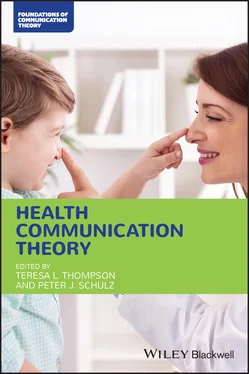1 ...8 9 10 12 13 14 ...22 Self‐monitoring is defined as individuals’ tendency to “exercise control over their expressive behavior, self‐presentation, and nonverbal displays of affect” (Snyder 1979, p. 86). This tendency is shaped by one’s individual perspective, as well as by personal and social experiences. Snyder’s (1974, 1979) original 25‐item self‐monitoring scale was composed to capture individuals’ (i) concern for social appropriateness (e.g. “It’s important for me to fit into the group I’m with”); (ii) attention to social comparison (e.g. “I try to pay attention to the reactions of others to my behavior in order to avoid being out of place”); (iii) ability to control and modify one’s behavior and image (e.g. “In social situations, I have the ability to alter my behavior if I feel that something else is called for”); (iv) ability to adapt oneself to fit particular situations (e.g. “I may deceive people by being friendly when I really dislike them”); and (v) ability to tailor one’s behavior and image to fit in (e.g. “In different situations and with different people, I often act like very different persons”). Since the conception of Snyder’s (1979) original scale, a revised shortened version of the self‐monitoring scale has been validated (e.g. 12‐items, Lennox and Wolfe 1984, O’Cass 2000), but there has been little recent measurement work on the scale.
As an audience segmentation variable, self‐monitoring allows for functional message matching (Briñol and Petty 2015; Carpenter, Boster, and Andrews 2013; Teeny, Briñol, and Petty 2016; Petty et al. 2017). Self‐monitoring is especially useful to promote health behaviors which may vary at the public versus private level (e.g. nutrition, exercise) as it has been successfully used to differentiate individuals in key compatible contexts (e.g. relationships, emotional displays, purchasing and brand selection, social media use; Graeff 1996; Kim, Seely, and Jung 2017; Oh et al. 2013; Snyder 1987). Compared to low self‐monitors, high self‐monitors tend to (a) identify socially‐appropriate expectations and adapt to them, and (b) seek to fit in with others, which results in them behaving differently in public versus private environments (DeBono 2006a, 2006b). High self‐monitors are easily influenced by advertising tactics that help them fit in (DeBono and Packer 1991; Shavitt, Lowrey, and Han 1992; Snyder and DeBono 1985), and they are more willing to try and maintain favorable attitudes toward products that help them look socially appropriate (DeBono and Packer 1991; Snyder and DeBono 1985). They need to look good in others’ eyes (Smith, Lair, and O'Brien 2019), they are notorious status seekers (Fuglestad and Snyder 2010), and impression managers (Kudret, Erdogan, and Bauer 2019), extrinsically motivated buyers (Shao, Grace, and Ross 2019), and more easily persuaded by attractive sources over expert sources (Evans and Clark 2012). In many respects, high self‐monitors are similar to individuals with high impression‐relevant involvement (Johnson and Eagly 1989). Conversely, low self‐monitors are less driven by social expectations or belonging, and their public and private behaviors are quite consistent with each other (DeBono 2006a, 2006b). Given these contrasts, health messages tailored to high self‐monitors ought to emphasize public gratification for the individual, improved social image, status, and need for belonging, and should be delivered by attractive sources. Such messages may involve a public pledge or affiliation with a visible cause, such as Susan G. Komen’s breast cancer awareness’ pink merchandize and fundraising runs (Susan G. Komen Foundation, n.d.), as well as organ donation logos and blood donation stickers for recognition. When addressing low self‐monitors, health communication campaigns may focus on intrinsically derived values, satisfaction, and using an expert source. Individuals with a range of self‐monitoring tendencies can create a host of challenges and opportunities for our priority audience. The final individual difference variable discussed in this chapter is sensation seeking.
Sensation seeking refers to people’s need to satisfy their desire for stimulating, exciting, and novel experiences (Zuckerman 1994). Individuals high in sensation seeking enjoy such experiences as riding extreme thrill rides (e.g. sky diving), and as a result, experience what they describe as a “rush” (Bardo, Donohew, and Harrington 1996). Since sensation seekers enjoy novel and intense experiences, they seek gratification in taking financial, legal, physical, and social risks (Zuckerman 1979, 1994). With relation to health behaviors, sensation seekers engage in risky behaviors such as drug use (Donohew 1990) and unsafe sexual activity (Donohew et al. 2000). Given their need and desire to perform risky behaviors, not surprisingly, sensation seeking has been recognized by health communication researchers and practitioners as an effective audience segmentation variable (e.g. Palmgreen et al. 2001).
The activation model of information exposure provides the theoretical framework for much of sensation seeking research (Donohew, Lorch, and Palmgreen 1998; Donohew, Palmgreen, and Duncan 1980), which stipulates that an individual has an ideal level of arousal at which they feel optimal comfort and that individuals seek to achieve and maintain this level of arousal when they are in situations of information exposure. Stephenson (2002) argued that individuals will continue paying attention to a stimulus that meets their arousal threshold. Otherwise, they look for another source of excitement to fulfill such a need. Therefore, the activation model of information exposure provides an explanation of how low and high sensation seekers react differently to health campaign messages, such that messages with structural and content features that are adequately arousing will appeal more to sensation seekers, whereas non‐sensation seekers may attend more to messages that cater more to their optimal level of arousal. Donohew, Lorch, and Palmgreen (1991) assert that “only when the message satisfies a desired level of arousal that individuals are likely to stay with it” (p. 207). It follows that a marketing message that appeals to non‐sensation seekers may not be adequately stimulating for sensation seekers to maintain attention to it. Conversely, messages that sensation seekers find stimulating may be perceived as too arousing by non‐sensation seekers. Hence, perceived message sensation is a determinant of the attention to and processing of messages.
Sensation seeking has also been studied in the contexts of HIV/AIDS prevention messages (Hull and Hong 2016), risky driving behaviors (Lemarié, Bellavance, and Chebat 2019; Zhang, Qu, Tao, and Xue 2019), student procrastination (Chen 2019), food supplement use (Hatch et al. 2019), and body piercing (Hong and Lee 2017). Among these studies, previous research investigated the role of sensation seeking on message processing with some finding no difference between low and high sensation seekers (Stephenson and Palmgreen 2001) and others reporting an interaction between sensation seeking and message processing and attitude (Stephenson 2002). An explanation for the mixed findings lies in topic differences. Stephenson (2002) argued that message topics which normally have more severe consequences tend to be of a higher sensation value. Messages considered high in sensation value are characterized as being dramatic, emotional, and novel (Palmgreen et al. 2001). On the other hand, messages with less severe consequences may be of a moderate sensation value, which makes it harder to detect message processing differences between low and high sensation seekers. Much like the previous individual difference variables introduced in this chapter, we see sensation seeking as an important segmentation variable to consider when advocating the health consequences associated with performing a risky behaviors.
Читать дальше












